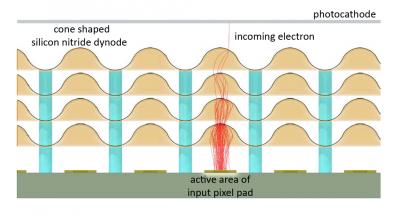Fabrication of Ultrathin Dynodes for Timed Photon Counter (Dynodes)
By means of MEMS technology a stack of miniature transmission dynodes placed on top of a pixel chip as charge sensitive segmented sensor can be developed. Instead of reflective dynodes, typical for photomultipliers, secondary electrons here are emitted from the bottom of the ultra-thin layers, after the impact of accelerated incoming electrons at the top. By placing those dynodes above special CMOS chip a single photon detector can be obtained (Timed Photon Counter, TIPC). The response time of such a detector is around 2 picoseconds. A first design consists of a single layer of curved thin membranes/dynodes fabricated by deposition of CVD silicon nitride onto a sacrificial template. The template is then removed by wet/dry etching. The dynodes will be tested to evaluate the Secondary Electron Yield (SEY). Depending on the outcome, other materials and/or configurations will be explored. Other aspects that must be taken into account while processing are stress profile, curvature and size of bell shaped dynodes.


Project data
| Researchers: | Violeta Prodanovic, Hong Wah Chan, Lina Sarro, Harry v.d. Graaf |
|---|---|
| Starting date: | October 2013 |
| Closing date: | October 2017 |
| Partners: | National Institute for Subatomic Physics Nikhef, Brookhaven National Laboratory, Photonis |
| Contact: | Lina Sarro |